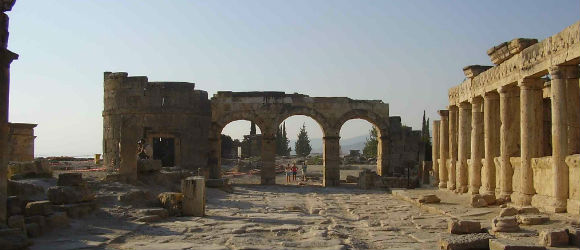The presence of a hot spring at Hierapolis and the spectacular calcium deposits from its water spilling over the nearby hillside suggest that there should be evidence of an early settlement there. The oldest Inscription found so far, however, indicates it was founded by Eumenes II, king of Pergamon, in the latter part of the second century B.C.; it soon became a busy industrial center.
Pagan worship in the city centered around Cybele, Apollo, Artemis, Men, Poseidon, and Pluto. Underneath the Temple of Apollo has been found the Plutonium, an opening in the earth from which a noxious gas still comes. The temple is between the pool where the hot spring rises and the large theater on the side of the hill. To the north along the rim of the plateau is a long avenue of tombs.
Traditionally St. Philip is connected with the early church in Hierapolis. Fairly recently Italian archeologlsts have discovered his Martyrium, an octagonal chamber forming a double cross surrounded by a square. This is almost due north of the theater, also on the side of the hill. It was a fifth century A.D. building and did not last much more than 100 years. No tomb was found with it although that was expected. There are several ruins of churches, one not far from the baths, one on the main road leading to the necropolis.
Hierapolis is listed in the New Testament along with Laodicea as the center of Epaphras’s work (Colos-sians 4:13). This was at the time Paul was writing to strengthen the message Epaphras was preaching and to condemn the “people who go in for self-mortification and angel-worship” (Colossians 2:18). Another less well-known resident of Hierapolis was Papias, a disciple of St. John and the author of the lost book called the Sayings of Jesus.
While Epaphras was is that area, a young slave was growing up in Hierapolis, a boy whose original name is unknown but whom we call by the Greek for “Acquired”, Epictetus. In his Discourses Epictetus often talks about the perfect missionary whose bed was the ground, whose only house the earth and sky and a shabby cloak, and who must love those who misuse him in the service of God. One wonders what the influence of those early Christians, many of whom were slaves themselves, was on this Stoic philosopher.
Hierapolis,


This site is just gorgeous. The calcuim rock formations are fun to explore for anyone. There are some pools of water that really are a torquies blue and some that are a little more muddy but they are all fun to see and play in.
The site is huge! First you walk through a roman bath area, it is a…
Well organized for visitors. To expensive entrance fee 70 TL.
Everyone who goes to Pammakule, goes to the pools but few venture further up the hill to the stunning ruins. Size wise, it is larger than the Roman forum. We had the place almost to ourselves. The tombs in the pools were hauntingly beautiful. The only bad thing was they don't label a clear path down without going back through…
We arrived at the far entrance which took us through Hieropolis. This was suggested by Turkey Trip Planner and yes there were no crowds. We found the ruins interesting. The ancient pool a novelty but it was crowded and there were little green algae blobs, but still a fun experience.Pamukkale also a novelty just a little crowded. I think the…
it was ok but i was kind of disappointed, the whole place just looked fake somehow. Maybe it is just me but it didn't look natural not for one second. I do think though one day it could have been naturally white but today i am sure there must some chemical product and heating system to heat the water instead…
Pamukkale means cotton castle in the Turkish language, and is named for the hot springs, travertines, and terraces of carbonate minerals that measure around 9000 feet long, and 500 feet high upon which the ancient city of Hierapolis was built. Visable from up to 20 miles away and a UNESCO world heritage site to boot, this natural wonder of the…
We had read in a few places that it had declined in quality over the years, but we fortunately disregarded all of this.
What a spectacular place. Entering from the bottom of the hill, you make your way up the travertine pools with hot spring water trickling past you. Pausing to take pictures and wade through pools will lengthen the…
There are historical ruins in that big area. There are Roman amphitheater and Greek amphitheater in the same area which were built in each era. You can swim in the spa pool with historical ruins sunken at the bottom with the extra fee. There were many people, so it was more like sitting in the tub, but it would be…
Wow…what a place!!!! The ruins are massive and so well preserved. You really dont get long enough with a trip…I wanted to look at every single thing!! Fantastic…well worth a visit.
its a good site for several hours walk and get feet wet in the thermal water on the way up/down the travertine hills, but its a little rough n slippery. the water temperature is comfortable. the ancient pool has thermal swimming pool with fee, food stall, restrooms, and souvenirs. i prefer the ruins of Ephesus. its too crowded!!!